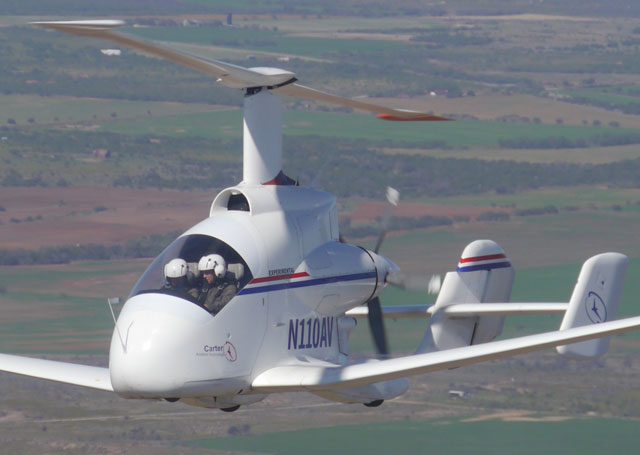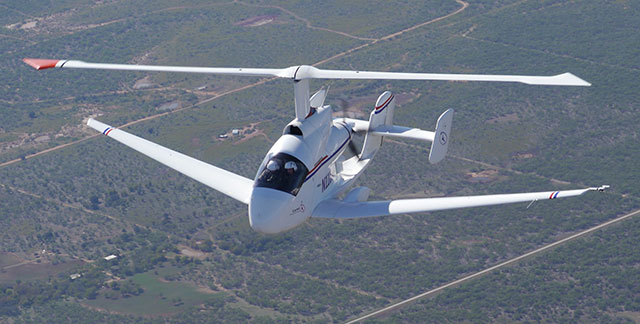
Breaking the μ-1 barrier, the helicopter speed limit that has frustrated generations of engineers, was one thing. Bringing to market an aircraft that leaps skyward in a single bound and then starts behaving like an airplane, an amalgamation of the two with controls both familiar and not, has been another.
A decade after the CarterCopter became the first rotorcraft to fly past μ-1 (where airspeed and rotor tip speed relative to the aircraft are equal) in stable flight, Carter Aviation Technologies of Wichita Falls, Texas, has pronounced the technology ready to scale up—way up—and is actively talking to two unnamed aerospace firms in hope of licensing the slowed rotor/compound technology for production.
Industry veteran Jon Tatro, hired by Jay Carter in 2013, has taken a lead role in the effort, and a new title: executive vice president for joint ventures and licensing. The former director of advanced concepts for Bell Helicopter said in a telephone interview that flight testing has proved the concept, and the past year has been spent “eking out the last bit of performance” from the Personal Air Vehicle, a proof-of-concept four-seat aircraft that may prove much smaller than what actually hits the market. Much depends on who buys the technology, and which mission is deemed most appropriate.
“We’re probably three to five years from a product,” Tatro said. “That’s three to five years after we get a deal.”
It has been five years since company President Jay Carter first started talking about bringing the prototype to market, starting with kits. Letters of intent had been signed, and Carter brought the four-place prototype to EAA AirVenture in 2009, though it took another three years for that prototype to surpass the μ-1 mark. Tatro said he gets calls and emails—two a week, or more—from potential customers wanting to know how much it costs and when they can get one. The company no longer talks about producing kits, however. The new focus is on striking a deal with a company (or investors) with the resources to pursue certification and set up an assembly line.
“We actually intend to host a test pilot from one of these major aerospace companies,” Tatro said, a visit that could take place in “less than two months, hopefully.”
That pilot is in for a treat. Flying the concept prototype requires unique procedures. The main rotor, which provides all the lift for takeoff and landing, and much of the lift in forward flight, is spun up on the ground with a flat pitch to speeds similar to a typical helicopter—about 350 to 400 rpm. The drive belt must be disengaged before the patented landing gear leaves the ground, or torque will make the aircraft spin like a helicopter without a tail rotor. With the rotor disconnected from the engine, the pilot then engages the pusher propeller to provide forward thrust (which can be done after takeoff as well, though test flights to date generally start with a forward roll). The fun really starts when another button is pressed, causing the main rotor to pitch for lift.
“That’s what we call our jump takeoff,” Tatro explained. Since the main rotor is now spinning free, there is no need for torque compensation (provided by the tail rotor in a traditional helicopter), so Carter’s concept aircraft can leave earth and gain forward speed in a straight line.
The rotor tips are allowed to slow to about 100 rpm in flight, with 75 pounds of added weight in the tips to provide extra inertia. Combined with the forward velocity created by the pusher propeller, the inertia allows the main rotor to produce lift and the aircraft is now more like an autogyro than a helicopter or airplane, though the wings do contribute to total lift and help achieve efficiency unheard of with traditional helicopters.
“This is where we have the huge problem with understanding and acceptance,” Tatro said. “Once we decouple …. We’re in autorotation for the rest of the flight.”
Flight controls include airplane-like rudder pedals that control rudders on the vertical tail surfaces for yaw control, and an automated system that controls the tilt angle of the main rotor mast to achieve optimal rpm for a given phase of flight.
“That’s all automated,” Tatro said, though “there is an override,” he noted.
The center-mounted stick has two grips, so the aircraft can be flown from either side, and it controls the ailerons, elevator, and the tilt angle of the mast, so it’s a combination of a helicopter cyclic and a traditional airplane stick. The nomenclature developed to date does not reflect the stick’s duality, however.
“No, I guess we hadn’t really given that a lot of thought. We call the stick a stick,” Tatro said. “Ignore the fact that there’s a rotor on the airplane, it’s (a) general aviation controls setup.”
When it comes to naming the aircraft (Personal Air Vehicle, the name given to the concept prototype, lacks pizazz), whoever puts it into production gets to choose, Tatro said. And the first versions to roll off a factory floor may be larger—much larger—than the four seater and its smaller predecessor flown to date. Carter envisions the concept being scaled up to transport aircraft, able to haul heavy loads with vertical takeoff and landing capability using half as much fuel (or less) as a comparable helicopter. The company has produced a variety of concept designs, including some crafted with offshore oil platforms in mind.
Tatro said the high efficiency and low rotor speed are a powerful combination that reduces noise as well as emissions, and exceeds long-term international goals on both counts. That may help convince regulators to cooperate with certification of an aircraft that fits neatly into no category, not to mention pilot requirements that fit neatly into no particular airman certification. Tatro remains optimistic that all of this can be accomplished in three to five years, however.
“That’s probably a realistic time frame,” Tatro said. “Then, it depends on the class of vehicle.”




